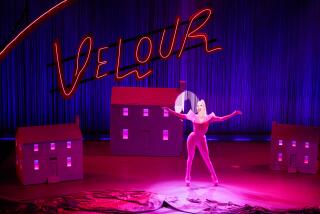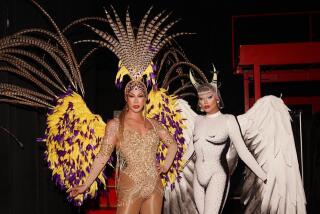‘The Most Beautiful Woman in the World’
He was a 200-pound man who squeezed himself into a corset with a 23-inch waist and size 4 high-heeled shoes.
His outrageous behavior earned him more money than the president of the United States, and a theater was named in honor of what many saw as his illegitimate, even shocking, stage conduct.
Julian Eltinge, the original King of Drag, pioneered modern female impersonation, becoming the world’s most ravishingly flamboyant illusionist on stage and screen from before World War I into the 1930s.
As sidelines, he published a beauty magazine, sold sheet music, founded a line of cold cream and a Hollywood social club, endorsed the Norda corset that reduced his 38-inch waist to 23 inches, and legally changed his name to spare his family embarrassment.
Eltinge’s credible cross-sexual masquerades shocked audiences just enough to draw gasps and giggles. Critics wrote of him: “It’s a crime that the most beautiful woman in the world is a man.”
He was born William Dalton in 1883 in Massachusetts. By age 10, it was hard for him to resist visiting the frilly side of the wardrobe rack; he made his stage debut in a dress at the Boston Cadet school’s annual theatrical presentation. His convincing female stage presence made him such a hit that the next year, when he was 11, the show was written around him.
Although men playing women onstage is as old a practice as ancient Greece and Shakespeare’s theater, it wasn’t until Eltinge was a teenager, when a smattering of drag queens were tentatively sashaying about, that the public took female impersonators to heart.
Eltinge made his Broadway debut at 21, in the musical comedy “Mr. Wix of Wickham.” The show failed, but the consummate showman was such a success as a showgirl that he put together other acts and toured the country and London for the next five years. One of his biggest hit musicals was “The Fascinating Widow,” in which he played both bride and bridegroom, and a bathing beauty.
Kings, queens and emperors--his unfailing cheerleaders--showered him with gifts, among them a bulldog named “Smith,” a gift from King Edward VII.
His onstage persona and the fact that he never married led to speculation about his sexuality. But Eltinge went out of his way to prove his masculinity. He once battled a “bunch of hoodlums” in a saloon who ribbed him about being a “swish.” He punched out a stagehand who called him “Lucy.” The same stagehand also let it be known that Eltinge was friends with the founder of a cutlery company in Sheffield, England. When the businessman died in 1907, Eltinge inherited his entire $1-million estate.
In 1912, when Eltinge’s weekly salary of $1,625 made him the best-paid act in vaudeville and exceeded that of President Taft, he and two colleagues opened the only theater ever built by a drag queen: the Eltinge Theater, later called the Empire, on West 42nd Street in New York.
As different as Eltinge himself, the theater offered seats for thin, average and plump patrons. (The theater was recently moved about 70 feet to make room for a new multiplex theater.)
Persuaded by film producer Jesse Lasky to come West and star in silent movies, Eltinge arrived in Hollywood in 1917, launching his film career in “The Clever Mrs. Carfax.” As in the other films he would make, he was portrayed at his insistence as a clean-cut, straight man forced into drag through some plot device.
To balance his drag persona with a more “butch” one offstage, his public relations firm photographed him laboring in overalls and in an unconvincing boxing match with “Gentleman Jim” Corbett. He also was often seen puffing on a cigar.
He preferred being called an actor or “America’s Leading Sex Simulator,” but others still referred to him as a “gay deceiver” and “the queerest woman in the world.”
But Hollywood loved him. The lights, costumes and scenery liberated a man who was a featured player in several comedies, including “The Countess Charming” (1917), “Over the Rhine” (1917) and “The Widow’s Might” (1918). Perhaps his chief footnote to fame was starring in “The Isle of Love” in 1922; a young actor named Rudolph Valentino had a supporting role.
Choosing Silver Lake as his home, he built a Moorish mansion he called “Villa Capistrana.” There, he entertained members of the Actors’ Colony, including Lasky, Mary Pickford and Geraldine Farrar in his Chinese Room, a red chamber with an enormous dragon artistically rendered on one wall.
At the same time that he brought his parents to live with him, he hired one of Los Angeles’ first landscape architects, Charles Gibbs Adams, who added a tropical garden of palms and water fountains that still survives on the property.
When he took off his high-heels, he sometimes donned cowboy boots, and he opened a dude ranch called Sierra Vista, east of San Diego. The 100-room ranch, which he touted as a retreat for men only, was the first financial mistake of his career. The second would not be of his own making--the stock market crash.
The crash put a dent in his substantial fortune; nature would take a toll on his career.
After the release of “Madame Behave” in 1925 and “Maid to Order” in 1930, he decided to semi-retire and hang up his frock. The films did fairly well, but the chin straps he used couldn’t disguise the fact that he was well over 40, and looked matronly on film.
More than that, though, there was a new puritanical sensibility in the nation, and drag was now thought to be a byproduct of homosexuality, and, as such, a threat to society. Eltinge found his once highly respected career criticized as immoral.
He rarely performed thereafter. Booked in 1940 at the Rendezvous--a somewhat seedy L.A. nightclub--Eltinge was forced to ax his act and emcee in a tux. The same year, a local ordinance required all female impersonators to take psychiatric exams before working professionally.
His final bow came a year before his death in 1941, when he made a cameo appearance with other vaudevillians in Bing Crosby’s “If I Had My Way.” Today, his gender-bending legacy survives in films and comedy acts, and his villa, the house that drag built, still stands.
More to Read
The biggest entertainment stories
Get our big stories about Hollywood, film, television, music, arts, culture and more right in your inbox as soon as they publish.
You may occasionally receive promotional content from the Los Angeles Times.










